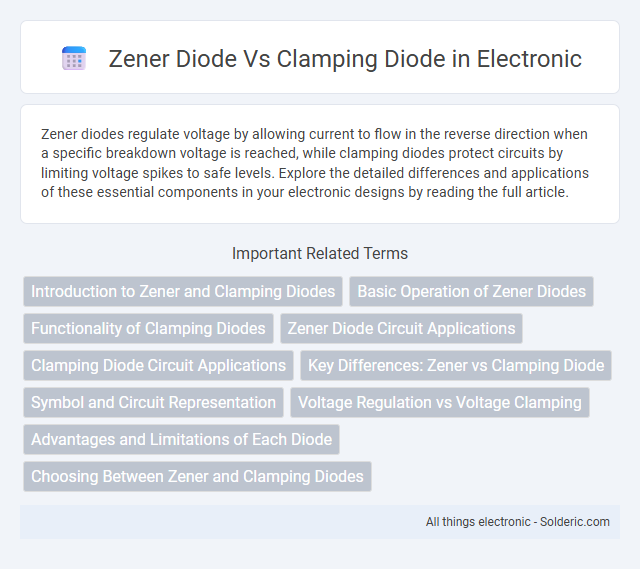Zener diodes regulate voltage by allowing current to flow in the reverse direction when a specific breakdown voltage is reached, while clamping diodes protect circuits by limiting voltage spikes to safe levels. Explore the detailed differences and applications of these essential components in your electronic designs by reading the full article.
Comparison Table
| Feature | Zener Diode | Clamping Diode |
|---|---|---|
| Primary Function | Voltage regulation and reference | Protects circuits by limiting voltage spikes |
| Operating Region | Breakdown region (reverse bias) | Forward conduction region for voltage clamping |
| Voltage Control | Maintains a constant voltage (Zener voltage) | Clamps voltage to a safe level |
| Typical Applications | Voltage regulators, voltage references | Overvoltage protection, transient voltage suppression |
| Connection in Circuit | Connected in reverse bias across load | Connected across or in series with signal line |
| Behavior During Normal Operation | Non-conductive until breakdown voltage | Non-conductive until voltage exceeds clamping threshold |
| Typical Voltage Range | 2.4V to 200V (Zener voltage) | Varies, depends on protection level needed |
Introduction to Zener and Clamping Diodes
Zener diodes are semiconductor devices designed to allow current to flow in the reverse direction when the voltage exceeds a specific breakdown voltage, making them essential for voltage regulation and reference applications. Clamping diodes, on the other hand, protect circuits by limiting voltage spikes, effectively clamping voltage levels to prevent damage to sensitive components. Unlike Zener diodes that regulate voltage within a circuit, clamping diodes act as protective barriers during transient voltage events.
Basic Operation of Zener Diodes
Zener diodes operate by allowing current to flow in the reverse direction when the voltage exceeds a specific value known as the Zener breakdown voltage, maintaining a stable voltage across sensitive circuits. Unlike clamping diodes that primarily protect against voltage spikes by redirecting excess voltage, Zener diodes regulate and stabilize voltage within power supplies. Understanding the basic operation of Zener diodes helps you design circuits with precise voltage regulation and improved reliability.
Functionality of Clamping Diodes
Clamping diodes protect electronic circuits by limiting voltage spikes to a predetermined level, preventing damage from transient voltage surges. Unlike Zener diodes that regulate voltage by operating in reverse breakdown, clamping diodes divert excess current away from sensitive components through a forward conduction path during voltage peaks. Their primary role is safeguarding circuits rather than precise voltage regulation, making them essential in electrostatic discharge (ESD) protection and signal integrity applications.
Zener Diode Circuit Applications
Zener diode circuit applications primarily include voltage regulation, where the diode maintains a constant output voltage despite variations in input voltage or load conditions. In surge protection circuits, Zener diodes clamp voltage spikes by conducting in reverse breakdown region to protect sensitive components. They are also used in waveform clipping and reference voltage provision for various electronic devices.
Clamping Diode Circuit Applications
Clamping diodes are widely used in protecting sensitive electronic components by limiting voltage spikes in circuits such as relay driver outputs, inductive load switching, and digital logic inputs. These diodes effectively clamp voltage to a specified level, preventing damage from transient voltages caused by inductive kickback or electrostatic discharge (ESD). Unlike Zener diodes, which regulate voltage by breaking down at a determined voltage, clamping diodes primarily serve as protective elements to maintain signal integrity.
Key Differences: Zener vs Clamping Diode
Zener diodes regulate voltage by operating in the reverse breakdown region to maintain a stable reference voltage, whereas clamping diodes protect circuits by limiting voltage spikes to safe levels. Zener diodes are primarily used for voltage regulation and reference in power supplies, while clamping diodes serve as transient voltage suppressors in signal and power lines. The key difference lies in their function: Zener diodes stabilize voltage under normal conditions, and clamping diodes act only during voltage transients to prevent damage.
Symbol and Circuit Representation
The Zener diode symbol features a bent bar on the cathode end, representing its ability to regulate voltage in reverse bias, distinct from the standard diode symbol. In circuit diagrams, Zener diodes are often shown connected in reverse bias across a load for voltage regulation applications. Clamping diodes use a standard diode symbol and are typically placed parallel to sensitive components to limit voltage spikes by redirecting excess voltage safely to ground or supply lines.
Voltage Regulation vs Voltage Clamping
Zener diodes provide precise voltage regulation by maintaining a stable reference voltage during reverse breakdown, ideal for protecting circuits from voltage fluctuations. Clamping diodes, on the other hand, offer voltage clamping by limiting voltage spikes to a predefined level, protecting your components from transient overvoltage conditions. While Zener diodes regulate continuous voltage levels, clamping diodes primarily prevent harmful voltage surges.
Advantages and Limitations of Each Diode
Zener diodes provide stable voltage regulation by operating in the breakdown region, making them ideal for voltage reference and overvoltage protection, but their precision decreases at higher currents and they have limited power dissipation. Clamping diodes rapidly divert voltage spikes away from sensitive components, offering efficient transient voltage suppression without precise voltage regulation, but they do not maintain a steady voltage like Zener diodes. Your choice between these diodes depends on whether voltage stabilization or transient voltage protection is the primary requirement in your circuit design.
Choosing Between Zener and Clamping Diodes
Choosing between a Zener diode and a clamping diode depends on the specific voltage regulation or protection requirement in your circuit. Zener diodes are ideal for maintaining a stable reference voltage by operating in their breakdown region, while clamping diodes are primarily used to protect devices by limiting voltage spikes and transient surges to safe levels. Your application's voltage tolerance, response speed, and precision needs determine which diode type provides the most effective and reliable solution.
Zener diode vs Clamping diode Infographic

 solderic.com
solderic.com